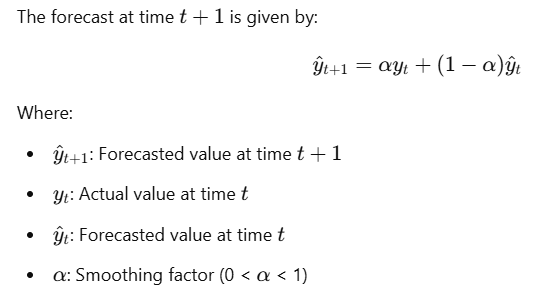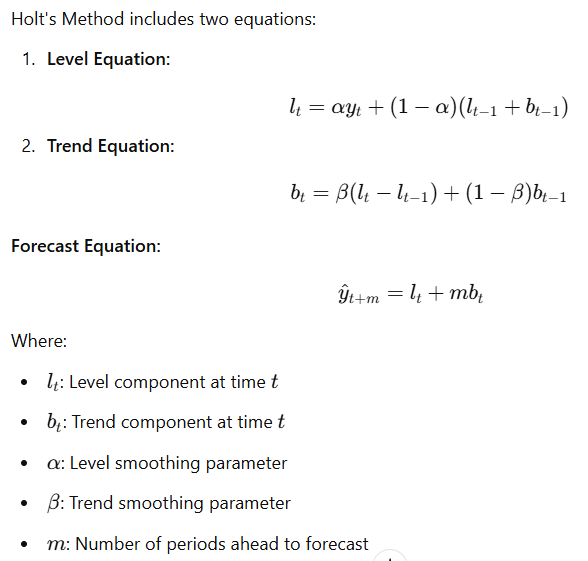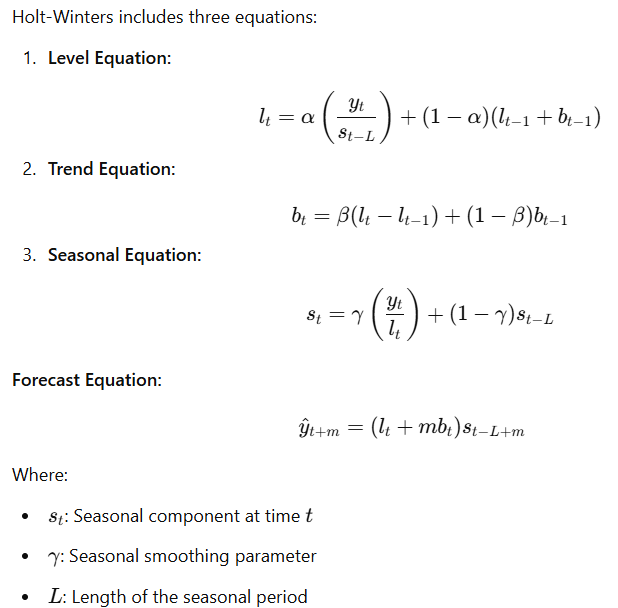Understanding Exponential Smoothing: An In-Depth Guide
 Sai Prasanna Maharana
Sai Prasanna Maharana
Exponential Smoothing is a family of forecasting methods that assign exponentially decreasing weights to past observations. These methods are widely used in time series forecasting due to their simplicity and effectiveness, especially when dealing with data that has trends and seasonality.
Table of Contents
Simple Exponential Smoothing (SES)
Concept
Mathematical Formulation
Advantages and Disadvantages
Python Implementation
Double Exponential Smoothing (Holt's Method)
Concept
Mathematical Formulation
Advantages and Disadvantages
Python Implementation
Triple Exponential Smoothing (Holt-Winters Method)
Concept
Mathematical Formulation
Advantages and Disadvantages
Python Implementation
Introduction to Exponential Smoothing
Exponential Smoothing methods are a set of time series forecasting techniques that apply decreasing weights to past observations. The weights decrease exponentially as the observations get older, hence the name "exponential smoothing."
Key Characteristics
Weighted Averages: Recent observations have more influence on the forecast than older ones.
Adaptability: Can be adapted to capture trends and seasonal patterns.
Simplicity: Easy to implement and computationally efficient.
Simple Exponential Smoothing (SES)
Concept
Simple Exponential Smoothing is suitable for forecasting time series data that does not exhibit any systematic trends or seasonal patterns. It forecasts future values based solely on past observations, with more weight given to recent observations.
Mathematical Formulation

Advantages and Disadvantages
Advantages:
Simplicity: Easy to understand and implement.
Requires Minimal Data: Only past observations are needed.
Good for Stationary Data: Effective when data lacks trends and seasonality.
Disadvantages:
Cannot Handle Trends: Ineffective for data with upward or downward trends.
Not Suitable for Seasonality: Cannot model seasonal patterns.

Python Implementation
Import Libraries
import numpy as np
import pandas as pd
import matplotlib.pyplot as plt
from statsmodels.tsa.holtwinters import SimpleExpSmoothing
Create Sample Data
# Generate synthetic stationary data
np.random.seed(42)
data = np.random.normal(loc=50, scale=5, size=100)
index = pd.date_range(start='2020-01-01', periods=100, freq='D')
df = pd.DataFrame(data, index=index, columns=['Value'])
Apply Simple Exponential Smoothing
# Initialize and fit the model
model = SimpleExpSmoothing(df['Value'])
model_fit = model.fit(smoothing_level=0.2, optimized=False)
# Forecast
df['SES_Forecast'] = model_fit.fittedvalues
Visualize the Results
plt.figure(figsize=(12, 6))
plt.plot(df['Value'], label='Actual')
plt.plot(df['SES_Forecast'], label='SES Forecast', color='red')
plt.title('Simple Exponential Smoothing')
plt.xlabel('Date')
plt.ylabel('Value')
plt.legend()
plt.show()
Double Exponential Smoothing (Holt's Method)
Concept
Double Exponential Smoothing, also known as Holt's Method, extends SES by introducing a component to model the trend in the data. It is suitable for time series data with a linear trend but without seasonality.
Mathematical Formulation

Advantages and Disadvantages
Advantages:
Captures Trends: Effective for data with linear trends.
Simple Extension of SES: Builds upon the simplicity of SES.
Disadvantages:
Not Suitable for Seasonality: Cannot handle seasonal fluctuations.

Python Implementation
Create Sample Data with Trend
# Generate synthetic data with a trend
np.random.seed(42)
trend = np.arange(100) * 0.5
noise = np.random.normal(loc=0, scale=2, size=100)
data = 50 + trend + noise
index = pd.date_range(start='2020-01-01', periods=100, freq='D')
df = pd.DataFrame(data, index=index, columns=['Value'])
Apply Holt's Method
from statsmodels.tsa.holtwinters import ExponentialSmoothing
# Initialize and fit the model
model = ExponentialSmoothing(df['Value'], trend='add', seasonal=None)
model_fit = model.fit(smoothing_level=0.8, smoothing_slope=0.2, optimized=False)
# Forecast
df['Holt_Forecast'] = model_fit.fittedvalues
Visualize the Results
plt.figure(figsize=(12, 6))
plt.plot(df['Value'], label='Actual')
plt.plot(df['Holt_Forecast'], label='Holt\'s Forecast', color='red')
plt.title('Double Exponential Smoothing (Holt\'s Method)')
plt.xlabel('Date')
plt.ylabel('Value')
plt.legend()
plt.show()
Triple Exponential Smoothing (Holt-Winters Method)
Concept
Triple Exponential Smoothing, known as the Holt-Winters Method, extends Holt's Method by adding a seasonal component. It is suitable for time series data with trends and seasonal patterns.
Mathematical Formulation

Advantages and Disadvantages
Advantages:
Models Seasonality: Effective for data with seasonal patterns.
Flexible: Can handle both additive and multiplicative seasonality.
Disadvantages:
Complexity: More complex due to additional parameters.
Risk of Overfitting: Requires careful parameter tuning to avoid overfitting.
Python Implementation
Create Sample Data with Trend and Seasonality
# Generate synthetic data with trend and seasonality
np.random.seed(42)
periods = 200
seasonal_periods = 12
trend = np.arange(periods) * 0.2
seasonality = 10 + 5 * np.sin(2 * np.pi * np.arange(periods) / seasonal_periods)
noise = np.random.normal(loc=0, scale=2, size=periods)
data = 50 + trend + seasonality + noise
index = pd.date_range(start='2020-01-01', periods=periods, freq='M')
df = pd.DataFrame(data, index=index, columns=['Value'])
Apply Holt-Winters Method
# Initialize and fit the model
model = ExponentialSmoothing(
df['Value'],
trend='add',
seasonal='add',
seasonal_periods=seasonal_periods
)
model_fit = model.fit()
# Forecast
df['HW_Forecast'] = model_fit.fittedvalues
Visualize the Results
plt.figure(figsize=(12, 6))
plt.plot(df['Value'], label='Actual')
plt.plot(df['HW_Forecast'], label='Holt-Winters Forecast', color='red')
plt.title('Triple Exponential Smoothing (Holt-Winters Method)')
plt.xlabel('Date')
plt.ylabel('Value')
plt.legend()
plt.show()
Forecasting Future Values
# Forecast the next 24 periods
forecast_periods = 24
forecast = model_fit.forecast(forecast_periods)
# Create forecast index
forecast_index = pd.date_range(
start=df.index[-1] + pd.DateOffset(months=1),
periods=forecast_periods,
freq='M'
)
# Plot the forecast
plt.figure(figsize=(12, 6))
plt.plot(df['Value'], label='Actual')
plt.plot(df['HW_Forecast'], label='Fitted', color='red')
plt.plot(forecast_index, forecast, label='Forecast', color='green')
plt.title('Holt-Winters Method Forecast')
plt.xlabel('Date')
plt.ylabel('Value')
plt.legend()
plt.show()
Conclusion
Exponential Smoothing methods provide a versatile set of tools for time series forecasting, adaptable to various data characteristics.
Summary of Methods
Simple Exponential Smoothing (SES):
Use Case: Data without trend or seasonality.
Advantage: Simplicity.
Disadvantage: Cannot model trends or seasonality.
Double Exponential Smoothing (Holt's Method):
Use Case: Data with a linear trend but no seasonality.
Advantage: Captures trends.
Disadvantage: Cannot model seasonal patterns.
Triple Exponential Smoothing (Holt-Winters Method):
Use Case: Data with trend and seasonality.
Advantage: Models both trend and seasonal components.
Disadvantage: Increased complexity and risk of overfitting.
Advantages of Exponential Smoothing
Flexibility: Can be tailored to different types of time series data.
Efficiency: Computationally efficient, suitable for real-time forecasting.
Adaptability: Parameters can be optimized for better forecasting performance.
Disadvantages of Exponential Smoothing
Parameter Sensitivity: Forecast accuracy depends on the choice of smoothing parameters.
Assumption of Linearity: May not perform well with non-linear patterns.
Limited to Univariate Series: Does not consider external variables or covariates.
References
Hyndman, R. J., & Athanasopoulos, G. (2018). Forecasting: Principles and Practice. OTexts. Online Version
Statsmodels Documentation: Exponential Smoothing
Brown, R. G. (1959). Statistical Forecasting for Inventory Control. McGraw Hill.
Subscribe to my newsletter
Read articles from Sai Prasanna Maharana directly inside your inbox. Subscribe to the newsletter, and don't miss out.
Written by
